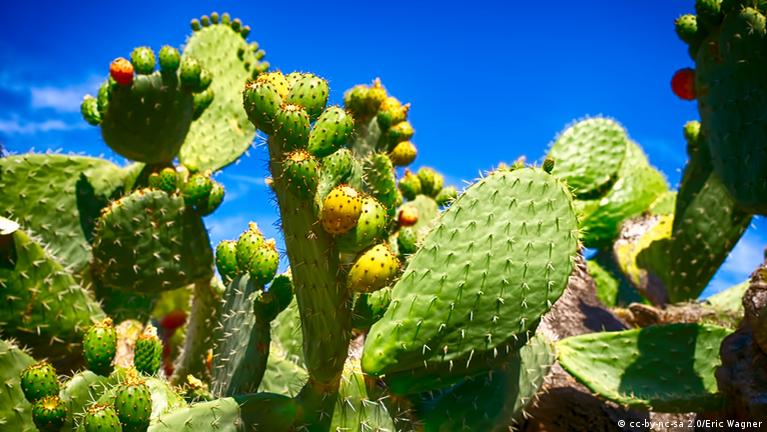Cactus Cultivation in Watershed Projects under WDC-PMKSY
The scope of WDC-PMKSY permits taking up suitable plantations of various kinds which help in restoration of rainfed/degraded lands. Cactus is the hardiest plant species which requires only scanty rainfall for its growth and survival. Accordingly, DoLR is exploring various options for taking up cactus cultivation on degraded lands for realizing the benefits of its use as 5 F i.e fuel, fertilizer, fodder, food and fashion (bio-leather, cosmetics) etc. for the larger benefit of the country and enhancing farmers’ incomes.
It is anticipated that bio-gas production from cactus would reduce fuel & bio-fertilizer import burden of the country, apart from developing degraded lands and contributing towards employment generation / livelihoods, increasing vegetation area, carbon sequestration and addressing climate change issues etc. in these areas.
At present, cactus cultivation is limited to only for fodder purpose in the country. The various other economic usages of cactus as explained above needs awareness, publicity and its promotion through facilitating availability of quality plantation material, package of practices and marketing avenues.

From review of literature, it is observed that no dedicated research/ field work to maximize production of spineless cactus has, however been undertaken in the country. Therefore, there is a need for taking up systematic research work on pilot basis at multiple locations for maximizing production of the best varieties of cactus available in the country and abroad. Accordingly, DoLR, Ministry of Rural Development has prepared Guidelines for
and circulated to all the States / UT of J&K and Ladakh for taking necessary steps for cultivation of cactus for generation of bio-gas and other usages (copy enclosed).A tentative minimum target of 10,000 ha is kept for undertaking cactus plantation under this initiative.
Progress made so far on use of Cactus for generation of bio-gas:
International Center for Agricultural Research in the Dry Areas (ICARDA) has established 2 cubic meter capacity bio-digester at their farm in Amlaha, Madhya Pradesh. After experimenting various combinations of cactus bio mass and cow dung as feed stock in the bio digester, ICARDA reported that with 90% cactus bio mass plus 10 % cow dung as feed stock generated bio-gas containing 65% methane.
International Center for Agricultural Research in the Dry Areas (ICARDA) has established 2 cubic meter capacity bio-digester at their farm in Amlaha, Madhya Pradesh. After experimenting various combinations of cactus bio mass and cow dung as feed stock in the bio digester, ICARDA reported that with 90% cactus bio mass plus 10 % cow dung as feed stock generated bio-gas containing 65% methane.
Now, DoLR has decided to undertake bigger pilot projects for generation of bio-gas using cactus as feed stock. Accordingly, DoLR in collaboration with States has initiated steps for plantation of cactus on large scale.
Bio-Fertilizer
The residue obtained from bio-digester, after methane production, could be applied to soil as a bio-fertilizer for improving soil properties as well as crop productivity. The bio-fertilizer obtained from digester has a high nutrient content; it is, hence, an important bio-fertilizer and permits to spare on the cost of commercial fertilizer. One tonne of bio-fertilizer is equivalent to 40 kg (Urea), 50 kg (potassium nitrate) and 94 kg (triple superphosphate). Besides, the cactus bio-fertilizer is rich in micro-organisms and organic material.
Bio-Leather
A pilot study at National Institute for Interdisciplinary Science and Technology (NIIST),Thiruvananthapuram, Kerala reported that 3 kg cactus produces 3.38 sq. feet of bio-leather which could in turn be used for making 2 pairs of bio-degradable chappals or 3 small size of bags or 2 pair of shoes.
Fruit
Cactus pear fruits are sweet in taste, juicy and nutritious. The fruit yield of cactus pear varies greatly, between and within countries ranging from 1 to 5 tonnes/ha in traditional production systems and from 15 to 30 tonnes/ha in intensive production systems. However, some irrigated orchards may yield upto 25 tonnes/ha. The high sugar and low acid blend of the fruits make it delicious and palatable. The pulp is the edible part of the fruit and is composed of water (84% to 90%) and reducing sugars (10% to 15%). Several traditional foods are prepared from cactus pear, including fruit-based products: jams, juices and nectars; dried fruit; juice concentrate and syrups; and liquors.
Fodder
Livestock production remains the main source of income for rural population living in drylands. However, the sector faces many challenges including feeding constraints and climate change. Under these circumstances, Cactus cladodes are used as a low cost green fodder for livestock especially in arid and semi-arid areas for cattle, sheep and goats. Cactus pear pads or cladodes “as inexpensive energy and water source” can be an important fodder. As a feedstock, nopal cactus can improve the quality of milk and meat due to its high value of essential vitamins and minerals.
Carbon sequestration
Carbon sequestration in drylands could be promoted or atleast conserved under cactus cultivation. Carbon is sequestered by plants through photosynthesis and may be stored in above ground biomass and by the roots. Cactus pear can play an important environmental role in the dry areas. It takes 550 mol CO2 per m2 cladode surface area daily. For example, five-year-old cactus pear plant that has 75 cladodes with an average of 0.09 m2 surface area per cladode can take 4,290 mol CO2 per day which is equal to 0.1892 kg / day (The total plant cladodes surface area is: 75 X 0.09 = 7.8 m2). In one year, one cactus pear plant can absorb 69 kg CO2.
Employment & Income generation
Cactus is a perennial succulent, drought resistant & multi-purpose crop with significant ecological, economic and social potential. It is an ideal candidate that can grow in the dry and degraded lands. As explained above, the cactus and its multitude varieties of products have immense potential for
which may prove very promising meeting Government’s objective of ‘doubling farmers incomes’ and livelihoods of the small and marginal farmers.

